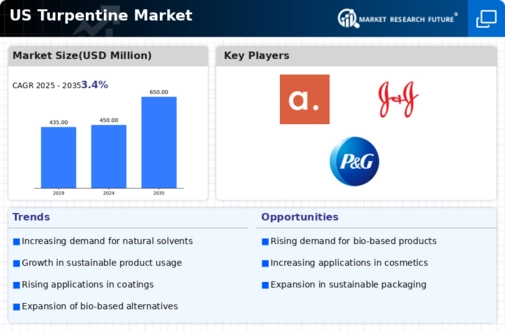The turpentine market exhibits a competitive landscape characterized by a blend of established players and emerging companies, driven by increasing demand for natural solvents and eco-friendly products. Key growth drivers include the rising applications of turpentine in industries such as paints, coatings, and adhesives, alongside a growing emphasis on sustainability. Major companies like Georgia-Pacific LLC (US), Kraton Corporation (US), and Pine Chemical Group Inc (US) are strategically positioned to leverage these trends. Georgia-Pacific LLC (US) focuses on innovation in product development, aiming to enhance the performance characteristics of its turpentine offerings. Meanwhile, Kraton Corporation (US) emphasizes regional expansion and partnerships to strengthen its market presence, while Pine Chemical Group Inc (US) is investing in digital transformation to optimize its supply chain and improve operational efficiency.
The business tactics employed by these companies reflect a concerted effort to localize manufacturing and optimize supply chains, which is crucial in a moderately fragmented market. The competitive structure is shaped by the collective influence of these key players, who are increasingly adopting strategies that enhance their operational capabilities and market responsiveness. This dynamic fosters a competitive environment where agility and innovation are paramount, allowing companies to adapt to shifting consumer preferences and regulatory landscapes.
In October 2025, Georgia-Pacific LLC (US) announced a new initiative aimed at increasing the production capacity of its turpentine products by 20%, a move that underscores its commitment to meeting the growing demand in the market. This strategic expansion is likely to enhance its competitive edge by ensuring a more robust supply chain and improved customer service. Similarly, in September 2025, Kraton Corporation (US) entered into a strategic partnership with a leading technology firm to integrate AI-driven analytics into its production processes. This collaboration is expected to streamline operations and reduce costs, thereby positioning Kraton as a more agile player in the market.
In August 2025, Pine Chemical Group Inc (US) launched a new line of eco-friendly turpentine products, aligning with the increasing consumer preference for sustainable solutions. This product line not only caters to the growing demand for environmentally friendly options but also enhances the company's brand image as a leader in sustainability. Furthermore, in July 2025, Resin & Pitch Co (US) expanded its distribution network across the Midwest, which is anticipated to improve its market penetration and customer reach, thereby strengthening its competitive position.
As of November 2025, the turpentine market is witnessing trends that emphasize digitalization, sustainability, and the integration of advanced technologies such as AI. Strategic alliances are increasingly shaping the competitive landscape, enabling companies to pool resources and expertise to drive innovation. The shift from price-based competition to a focus on technological advancement and supply chain reliability is becoming evident. Companies that can effectively differentiate themselves through innovation and sustainable practices are likely to thrive in this evolving market.














Leave a Comment